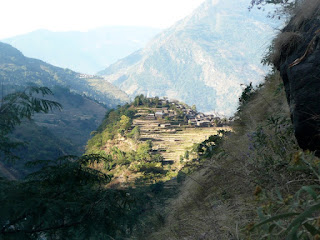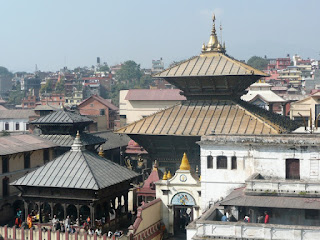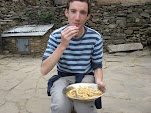(Sung to the tune of REM)
However, on our return, the bridge across the river was completely blocked. No-one was going anywhere. I was late, and needed to get to my office, and Achut had to get back into Thamel. So I jumped off the bike and told Achut to turn round and go back home, whilst I walked to my office. After crossing the bridge I understood the reason for the jam. Riot police were turning round all traffic, sending them back into Kathmandu. Just past them, another 20 or so police were in negotiations with an increasing rowdy mob of protesters. People were standing on the pavements, watching, not quite knowing what to do. I joined them. I saw the road I wanted to go down and avoid it, however, the protesters were between me and the road. Would it be safe enough to walk there?

I gradually inched down the road, trying with my 6ft3 frame to hide behind Nepali people, as befitting a brave and courageous person. As I reached the junction for my road, another larger protest also reached the junction for the road, shouting slogans against the Maoists. There seemed to be plenty of people just standing and watching, so I thought I wold join them, making sure I knew my escape route if anything happened. But nothing did at the time. And so I climbed from the river via the back roads to my office.

When I returned to my office, I found out that it was victims of the Maoist atrocities, during their self-proclaimed 'People's War'. These people had their husbands, wives, brothers, sisters or children abducted and murdered by the Maoists, now in power in Nepal. In a way, it is a testament to the Nepali people that they can forgive the Maoists for their previous activities - just to point out the Nepal Army were also guilty of performing similar acts. However, it makes wonder, how much about these abductions and murders did the higher echelons of the party knew. If they sanctioned it, then they have blood on their hands. If they didn't know, then they have no control over their party - which could explain a lot of the current problems. And should people with the blood of 13,000 be allowed to lead a country? But then there is also reconciliation, an important part of peace. It's a tough problem. Sometimes I'm glad I'm just an engineer.
We had a great quiet Christmas here in Nepal. I was invited out to an ex-pat's house on Christmas Eve for a get together and carols, which really got me into the spirit of things. Christmas morning I woke up, realising I forgot to put out my stocking and mince pie for Father Christmas. D'oh. Not being at home also meant that I couldn't wake up stupidly early and annoy my parents, just as I do every year.
There was a big Christmas program in St Xavier's School here in Lalitpur, but I didn't go in the end as I was waiting for Saru to turn up. However, they say 7,000 people did - mostly Nepali - which is great news for the church here. We had a normal daal bhaat for morning meal, but after Saru came, the cooking went into overdrive. Pilau rice, meat for us meat eaters, and some most amazing pickle from lopsi - like a lychee, but less sweet and an edible skin.
With my little christmas tree, I put the presents I had bought for all my Nepali family under it, and then when 15.10 came - the time the Queen's speech in the UK would finish, I passed out the presents. Rachhu surprised me by giving me a model of Krishna Mandir from Patan Durbar Square as well.
In the evening, we lit candles under the christmas tree. I told the christmas story, and explained the 5 candles used in the advent crown. Then we all sat around the tree trying to warm our hands as much as possible on the heat from the candles.

Boxing Day, and Saru left in the morning with me. I made my way to the office - the problem with Nepal is it has its own national festivals, and they certainly aren't ours. So our office was open, and I thought I had better go in.
And so, tomorrow I'm off to the plains - the Terai - to Didi's house and really looking forward to it. I promised I would go to her house a long time ago, but for one reason and another haven't made it there since May. It should also be a lot warmer there. Wahey!
SAM
Here's some gratuitous pretty pictures from earlier this year which I don't think I've shown before. (And by the way, that red picture of the mountains was taken from my roof, not a painting, i can assure you.)

















